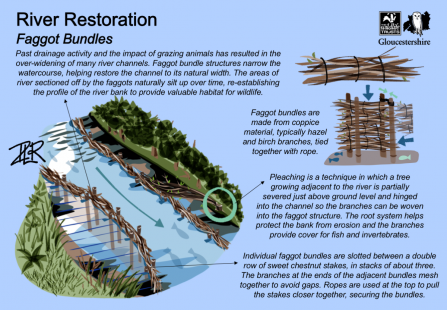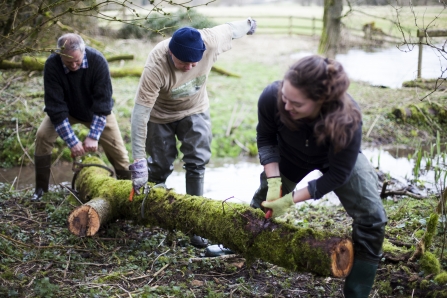About the project
This section of the river Coln between Fossebridge and Bibury was re-routed to the edge of the floodplain many centuries ago to allow space for a water meadow system. This has resulted in a straightened river, devoid of the processes of erosion and deposition found in a natural meandering river. These natural processes create variation in both the rivers width and depth, which in turn provide multiple niches for flora and fauna. Our river restoration work is trying to mimic these natural processes.
The work on the River Coln was carried out by staff and GWT volunteers using river restoration techniques that offer multiple benefits for both people and wildlife. These benefits include reducing the risk of flooding, restoring natural habitats, improving water quality and helping to make catchments more resilient to the impacts of climate change.
The river restoration techniques that were used on the River Coln included:
Faggots/Fascines
When we worked on the River Coln we used bundles of hazel tied down between a double row of sweet chestnut stakes, to narrow the river and prevent further erosion. Faggots or fascines are bundles of coppice material (typically hazel) that are secured in place at the base of the river bank. Faggots are used to encourage natural siltation and help protect banks from locally damaging erosion, often below the water level.

(c) Imogen Lois Robertson
Flow Deflectors
Flow deflectors are essentially large pieces of wood positioned on an angle facing upstream, with one end pushed tightly into the bank. The timber stretches across roughly one third of the river and creates turbulence in the water, especially in mid-stream. This turbulence then scours out the riverbed creating a hollow with a gravel bank downstream.
On the River Coln, paired sections of flow deflectors were fixed into the bed to create an upstream ‘V’ shape, these mid-channel deflectors will clean and sort the gravel through scouring and help create the correct conditions for spawning trout.

Moving a large piece of timber into the River Coln - Ruth Davey
Shade Reduction
Successful bankside management requires a balance between shaded and open areas of water. Dense shade destabilises banks and inhibits aquatic and marginal vegetation, which is vital for Water vole and other wildlife. Cutting bankside trees allows increased light and consequently promotes the growth of marginal vegetation.
When we worked on the River Coln, some volunteers focused on reducing shading of the channel. Smaller trees were also pleached into the water, this coppicing technique involves cutting two thirds into the wood and hinging the tree into the channel where it can be fixed into place. Pleached trees are still alive and help stabilise the bank whilst also creating in stream habitat for fish and invertebrate species.
The benefits of this work include:
- Improving riparian biodiversity
- Reducing the risk of flooding in the River Coln catchment
- Creating valuable habitat for wildlife and people
- Partnership working between landowners, local residents and organisations
- Creating a river catchment where water management is fully integrated into land management practices









